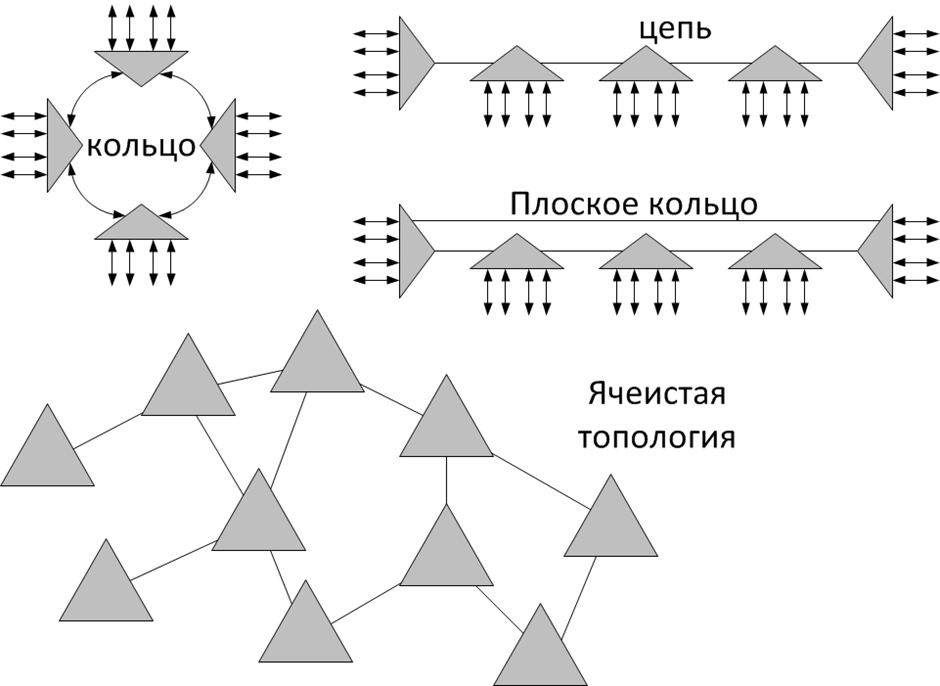Compensation of frequency synchronization error
The pointer can not only fulfill a fixed phase shift and mismatch clock multiplexer clocked device, from which the user data is received. To compensate for this effect, the index value is periodically incremented or decremented.
Positive alignment - The pointer is incremented by one, reflecting the delay start of the next container VC-4, three bytes.
Negative alignment - to accommodate the "extra" bytes used three younger byte pointer, ie the NT box (the pointer itself fits in fields H1 and H2)
Typical SDH topology

Typical SDH topology
Methods to ensure network survivability
In SDH the term in the automatic protection switching (Automatic Protection Switching, APS) is used as a generic name of fault tolerance mechanisms. Usually, this mechanism is realized through the following types of backup:
- Protection 1 + 1 means that the backup member does the same job as the principal. For example, in the protection tributary card 1 + 1 as the traffic passes through the working card (redundant), and through the protection (backup).
- Protection of 1: 1 means that the security element is not normally perform the functions of the protected element and are only switched on in the event of failure.
- Protection 1: N will provide the same security element at the N protected.
Equipment Protection Switching, EPS - the protection units and elements of SDH equipment.
Card Protection, CP - Protection of aggregate and tributary multiplexer card, allows the multiplexer will automatically continue to work in the event of failure of one of the aggregate or tributary cards.
Multiplex Section Protection, MSP - that is, the network portion between two adjacent SDH multiplexers, acts more selectively than with protection cards.
Sub-Network Connection Protection, SNC-P - that there is a protection path (connection) through the network for a particular virtual container allows the user to switch a specific connection to an alternate path in case of failure of the main road.
The new generation of SDH protocols
With the development of Internet information transmission system began reorienting the process to voice traffic on a computer, but the existing SDH systems were not friendly enough for this type of traffic with speeds 10/100/1000/10000 hierarchy.
As a result, the organization of ITU-T has developed several standards that make up the so-called new generation SDH technology (SDH Next Generation, or SDH NG). These standards do SDH technology more friendly to computer data.
Next Generation SDH standards define three new mechanisms:
- Virtual Concatenation (VCAT);
- Dynamic changes in link capacity (LCAS) scheme;
- General procedure of encapsulation (framing) data (GFP).
Virtual Concatenation
Virtual Concatenation, VCAT of containers capacity allows the use of SDH virtual containers more efficiently by transmitting Ethernet traffic. In virtual concatenation mechanism there is precursor of - mechanism adjacent concatenation.
This mechanism has been developed for more efficient transmission of traffic ATM network; it allows to join several containers VC-4 at a rate of 140 Mbit / s into one container at a higher data rate. The coefficient of multiplicity association VC-4 containers in an adjacent concatenation mechanism can be set to 4,16,64 or 256 that can be used for the transmission of several combined (concatenated) VC-4 containers in the STM-4 frames, STM-16, STM-64, or STM-256
Virtual Concatenation allows much more efficient spending capacity SDH network with Ethernet traffic transmission. For example, to transmit one stream of Fast Ethernet 100 Mb / s, STM-16, the network can use a virtual concatenation of VC-12-46v, which provides bandwidth for user data 100,096 Mbit / s (i.e., gives an almost 100-percent loading of the combined container ) and the remaining 206 containers VC-12 (STM-4 frame accommodates 63 x 4 = 252 VC-12 containers) for use as a Fast Ethernet transmission of other flows, and to transfer voice traffic.
Scheme dynamically change link capacity
Driving dynamic change line capacity (Link CapacityAdjustment Scheme, LCAS) is in addition to the mechanism of virtual concatenation. This arrangement allows the initial multiplexer, ie the one that generates the combined container dynamically change its capacity by connecting to it or disconnecting from it a virtual containers. In order to achieve the desired effect, the source sends a final multiplexer multiplexer special service message, a notification of change in the composition of the combined container.
The general procedure for data encapsulation
Общая процедура инкапсуляции данных (Generic Framing Procedure, GFP) предназначена для упаковки кадров различных протоколов компьютерных сетей в кадр единого формата и передачи его по сети SDH.
- Alignment of computer speed and protocol speed SDH virtual container used for the transmission of computer data. GFP procedure supports two modes of operation: GFP-F (frame mode or Frame Mode) and GFP-T (transparent mode, or Transparent Mode)
- Recognition of the beginning of the frame. The procedure for detecting GFP frame is beginning its own header, which consists of a length field is two bytes in size and length of the control field and a checksum field is two bytes in size
